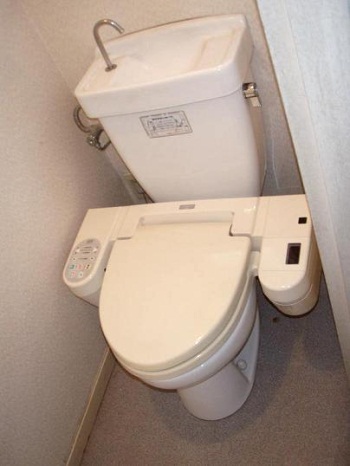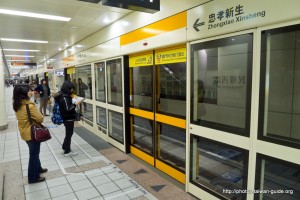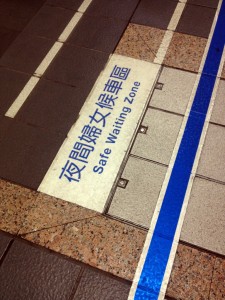While living in Asia means that we have to do without some Western amenities (like an oven), Steve and I have gotten quite used to a few innovative things here. We’ve also learned that necessity is truly the mother of invention. Asian cities are some of the world’s most densely packed places, and constrained natural resources and space made these innovations not only helpful but necessary.
One of the first things that we saw in Japan (literally) was a toilet with a small faucet and sink on top. We were at our host Ken’s house, and I swore up and down I’d get a photo, and of course, I forgot, but luckily, plenty of other people online have documented these toilets. Much like some European houses, Japanese toilets tend to be in a different room from your sink and shower business, so to make it easy for you, when you flush, the water comes out of the faucet. You can wash your hands, and the dirty water will flow directly into filling the tank. Pretty brilliant. My family uses a number of water-saving techniques in the bathroom, but it’d just be simpler if versatile water usage were the norm that we strived towards!

Something else that we saw in China but also in plenty of other countries are countdown stop lights. They have them here in Taiwan as well, and let me tell you, I don’t know how we got around without them!

This is pretty self-explanatory and very easy to get used to. When the light turns red, it counts down from however long the red light lasts (usually 60 to 40 seconds, depending on how big the intersection is) and there’s a good five second pause between when the cross traffic ceases and the countdown ends. They build that in to make sure people definitely get out of the intersection, which is a great tactic in countries where people like to bend the rules of traffic a little. (Don’t even get me started on Taiwanese scooters!) Then the numbers switch to green and begin to count down the green light as well. There is usually one for pedestrians and bikers too and here in Kaohsiung, the little green countdown is sandwiched between little animations of a woman biking and a man walking, both of which speed up when the countdown is less than 10 seconds.

I don’t know of anything else that I rely on as much as this, man. Jaywalking isn’t too common (or easy) given that the roads are typically well planned and rather large. It’s harder to jaywalk across a four lane boulevard with side medians for scooters and slower traffic. Taiwanese scooter drivers also don’t have any problems with right turns (or left turns, sometimes) on red, so you’re usually obliged to wait and watch until it’s your time and then hustle, basically.
Now, I’ve prepared an epic hymn to the subway systems in Asia. No, seriously, I kind of love the transit systems here. In Taiwan, the subway is known as the MRT, or mass rapid transit (Simplified Chinese: 捷运). Constructed around 2008, Kaohsiung’s MRT is relatively recent and consequentially has low-ish ridership, though its numbers have been increasing. Everywhere else we’ve been, however, the MRT has shown its flexibility and power in carrying vast numbers of people around a metropolis. Here are some ridiculous daily average ridership numbers: 8.7 million (Tokyo), 9.75 million (Beijing), 7 million (Shanghai). How do they do this daily shuffle of a population easily three times the city of Chicago? Easy-peasy. With a few innovations.

Paint on the floor. It’s that simple! Well, it gets simpler when you have a slightly smaller ridership. The Taipei Metro carries a paltry 1.7 million (okay paltry compared to Beijing) every day, and everyone I saw there lined up nice and neat according to these lines. Better yet, for example, if these lines at one door curved off to the left, then chances were, the lines at the next door down curved to the right, so that people coming in were all clustered together. It’s a little hard to describe, but let me just reassure you that people in Taiwan and Japan followed these rules pretty well. Of course, rules can be bent a little bit in China. On the Beijing subway platform, there were also lines so people could line up in twos on the right and left of a door, but they pushed and pulled like nobody’s business. (Steve was really polite at first, but that changed rather quickly.) Even at non-rush hour times, the lines were so long that we were forced to often wait for a second train. It took about an hour to get anywhere in Beijing via subway, so we got really adept at figuring out who looked like they were about to get off, and casually moved over to have a shot at grabbing their seat.
Also, I really admire the little things on the Taiwanese MRT. For example, they have these Breastfeeding Rooms and unusually clean bathrooms. Then there are these “Safe Waiting Zones” (in Chinese, they translate to: Nighttime Women’s Waiting Zone, so you know what they’re really for) where people are encouraged to wait for the train during nighttime or if they don’t feel safe. There are cameras trained on those spots so they can better monitor the platform. Having not seen these in action, of course, they could be of limited use, but I certainly think it’s a great idea!

To leave you on a harmonious note, the sweet sound of music tends to help. When trains are about to close their doors, it’s indicated by a short segment of music. Here’s two examples: one from Kaohsiung which we hear every day, and the other from Tokyo, which we also really enjoyed listening to. I just spent about 20 minutes researching all manner of different subway jingles from Taiwan and Japan. Strangely, not a Chinese thing? Anyway, the tone of the music usually makes it very recognizable what’s about to happen, even if you’re not familiar with the practice. It also is a little less jarring than someone yelling at you, “Doors about to close!” (I’m not even looking at you, CTA.)
They also have a delightful tune in Kaohsiung that tells you the train’s about to arrive. All the videos I could find are of the original tune, which is probably a little better than what they have now, which is a cheerful female voice over the music saying “The train’s about to arrive!” and announcing some sort of short advertisement deal. FYI in case of confusion, in the video below, the arrival tune is followed immediately by the doors closing tune for the train heading in the opposite direction.
Another day, I will write a long post about 7-11. Yes, Seven Eleven is well known to Americans, but not in this incarnation in Asia, and deserves a whole long post about how awesome it is all by itself.
Until next time!
Connie
I’ve always found the KRTC song to be utterly endearing. Last time I was in town there weren’t ads or a female voice over it. How annoying!
I vote 7/11 post.